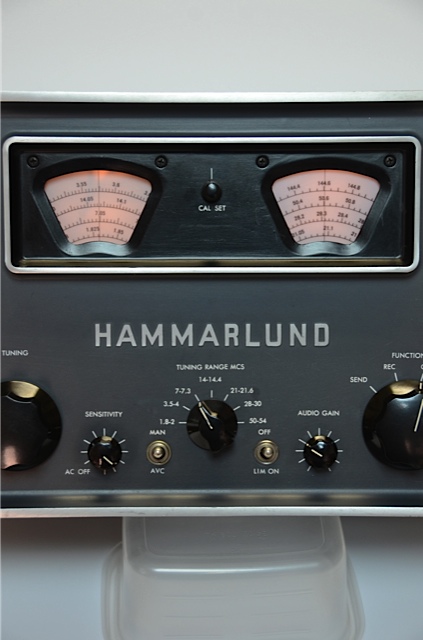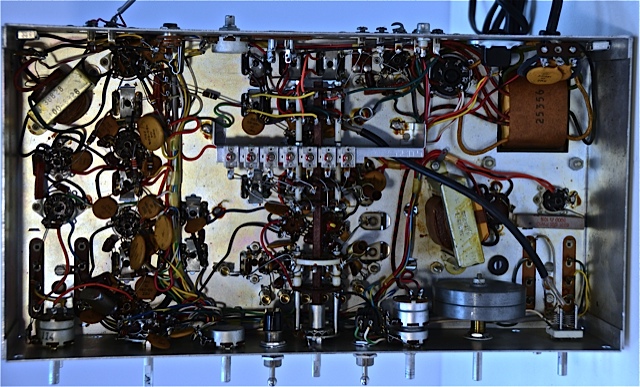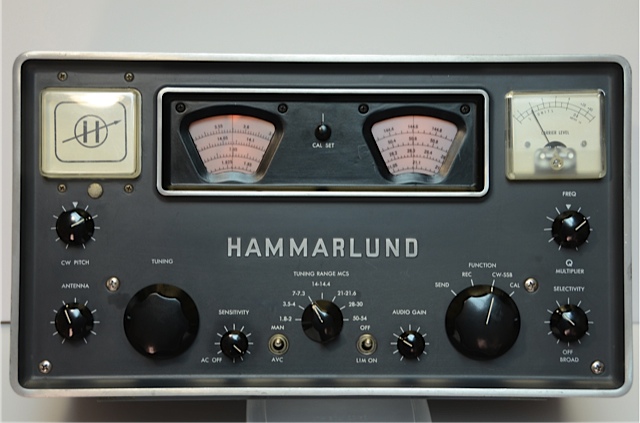|
Hammarlund HQ-110A Ham Band Only Receive.
When I received my ham radio licence in 1959,
Hammarlund receivers were my dream. But that is what they were, only a dream
as the Canadian Input Duty Tax put even the lowest cost HQ-110 beyond my reach.
The HQ-110A is an 12 tube dual conversion superhetrodyne
circuit with Q multiplier, a 100 KHz calirator and
an AM plus a CW/SSB linear product detector. In 2011 I saw an add on eBay for
a HQ-110A offered for sale as "not working" so I bid and it was soon
sitting on my work bench. After close inspection I was pleased that it was
cosmetically in very good condition other than accumlated
dust and dirt. As well it is a late production number with the last of the
Hammarlund improvements to the A model.

A picture of the back with the label shows the model number (HQ-110A), tube
lay out and back panel connections.

A close inspection of the band selection knob shows the HF ham bands allowed
back when it was made. It covers 160 to 10 meters as well as 6 meters which
the earlier HQ110 did not have. 160, 80, 40 and 20 meters are on the left
dial with dial marking every 5 KHz. The right hand dial is calibrated for 15,
10, and 6 meters with 10 KHz dial markings. This dial is also calibrated for
an optional 2 meter converter.

This picture shows the dial markings on the left dial which for the day was
quite a accurate frequency display for such a low cost receiver.

The first step was to take the chassic out of the
cabinet and inspect it for any obvious signs of burned components or other
tell tail signs of a failed component. The top looked good with no signs of
rust on the steel chassic. I spent a couple of
hours with a vacuum cleaner sucking up the dirt and dust then washing and
buffing everything with steel wool (except for the dials). When I was
finished cleaning it looked like it came directly from the factory.

I decided to take the dials off so I could clean them properly and also
lubricate the dial shafts bearings. Here is a picture of the front after
dials were cleaned and re-installed.

Now it was time to find out why the receiver was dead. Acutally
with the RF and Audio gain control set for maximum gain there was a light
hiss coming from the speaker. First I did a few resistance checks and then
with the receiver turned on I checked voltages at various points and no
readings were unexpected.
I hooked up my HP8640B signal generator to the receiver and when I increased
the generator power to a high level I was able to hear the generaor though faintly. The generator frequency was way
different than what the receiver dial indicated. This led me to believe that
the whole receiver was seriously out of alighment.
Following the instructions in the manual I began to methodically align the
receiver, first the 2nd IF coils. Obviously some one had adjusted the IF
coils but not near to the correct frequency. I followed with the 1st IF coil
and then on to the VFO oscillator, mixer and RF input coils. It took me a
while to realize that the manual shows the wrong HF Oscillator coil locations
in Figure 7. From left to right, the correct location of the HF Oscillator
coil is 54, 30, 21.6, 14.4, 7.3, 4 and 2.0 MHZ.
After I aligned the receiver I checked the sensitivity of the reciever. I was amazed how sensitive this mid 1960
low-end ham receiver was. I am able to clearly hear a CW signal with an input
of -130dBm on all bands 160 to 10 meters. As well I had forgotten how sharp a
Q multiplier is when properly adjusted. What a delight to tighten up the bandwith when other signal creep near by.

The HQ-110A now proudly sits on the top shelf of my operating desk. I often
use it to listen to W1AW CW bulletins, to AM boatanchor
hams or quickly tune across the bands to check conditions.

|